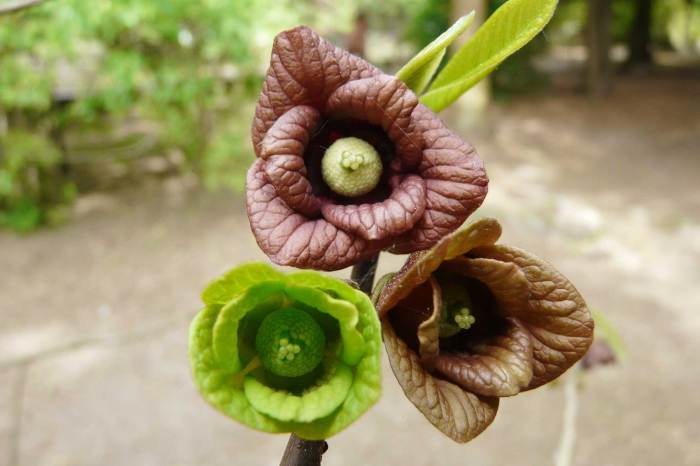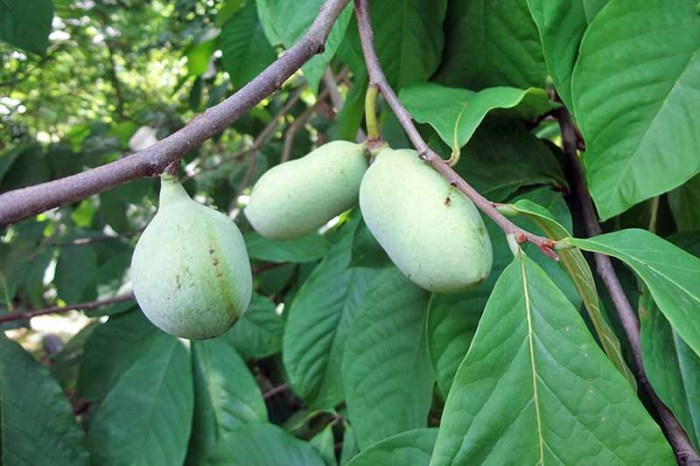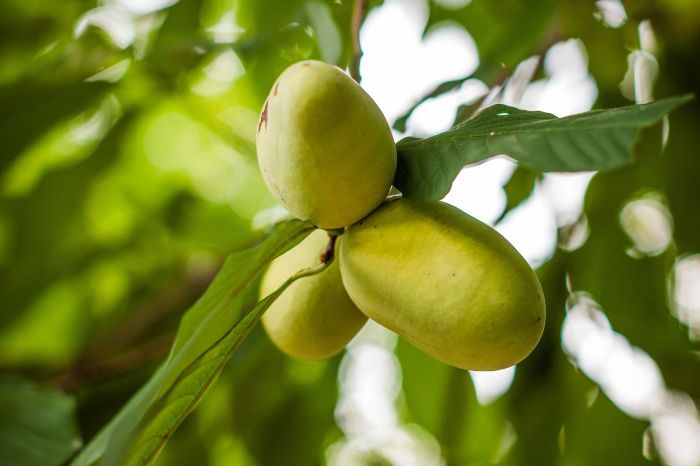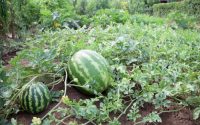Where to Plant a Pawpaw Tree
Soil Conditions for Pawpaw Trees

Where to plant a pawpaw tree – Successful cultivation of pawpaw trees hinges significantly on providing them with optimal soil conditions. The health and productivity of these trees are directly influenced by the soil’s pH, drainage capabilities, and overall composition. Understanding these factors is crucial for establishing a thriving pawpaw orchard.
Pawpaw trees, unlike some fruit trees, exhibit a degree of adaptability. However, their preference for specific soil characteristics cannot be overlooked. Providing the ideal environment maximizes their growth potential and fruit production. Failure to address soil inadequacies can lead to stunted growth, reduced yields, and increased susceptibility to diseases.
Soil Characteristics Favoring Pawpaw Growth
The ideal soil for pawpaw trees possesses a combination of characteristics that promote robust root development and overall plant health. These characteristics are crucial for ensuring the tree receives adequate nutrients and water while maintaining a healthy root system. Ignoring these factors can significantly impede the tree’s ability to thrive.
- pH Level: Pawpaw trees thrive in slightly acidic to neutral soil conditions. The optimal pH range is generally between 6.0 and 7.0. Soil pH outside this range can affect nutrient availability, impacting growth and fruit production. For example, excessively acidic soil (pH below 6.0) can lead to nutrient deficiencies, while highly alkaline soil (pH above 7.0) can hinder the uptake of essential micronutrients like iron and manganese.
- Drainage: Well-drained soil is paramount. Pawpaw trees are intolerant of waterlogged conditions, which can lead to root rot and other fungal diseases. The soil should allow for efficient water percolation, preventing water from accumulating around the roots. Clay soils, known for their poor drainage, often require significant amendment to be suitable for pawpaw cultivation. Conversely, sandy soils, while well-draining, may require amendments to improve water retention.
- Soil Composition: Pawpaw trees prefer a soil that is rich in organic matter. This provides essential nutrients, improves soil structure, and enhances water retention. Loamy soil, a mixture of sand, silt, and clay, is generally ideal due to its balance of drainage and water retention capabilities. The presence of organic matter, such as compost or well-rotted manure, further enhances soil fertility and overall suitability for pawpaw cultivation.
Consequences of Unsuitable Soil Conditions
Planting pawpaw trees in unsuitable soil can have several detrimental consequences, significantly impacting the tree’s long-term health and productivity. These consequences can range from minor setbacks to complete failure of the tree to thrive.
- Stunted Growth: Poor drainage or inadequate nutrient availability leads to stunted growth, resulting in smaller trees with reduced yields. Nutrient deficiencies, particularly those of iron and manganese, can manifest as chlorosis (yellowing of leaves).
- Reduced Fruit Production: Trees grown in unsuitable soil produce fewer and smaller fruits. The quality of the fruit can also be compromised, with reduced sugar content and flavor.
- Increased Disease Susceptibility: Poorly drained soil creates an environment conducive to fungal diseases, such as root rot. These diseases can severely damage or even kill the tree.
- Premature Death: In extreme cases, unsuitable soil conditions can lead to the premature death of the pawpaw tree.
Amending Poor Soil for Pawpaw Cultivation
Improving the soil’s suitability for pawpaw growth often involves amending the existing soil to correct deficiencies in pH, drainage, and organic matter content. This process can significantly enhance the tree’s chances of success. The specific amendments needed will depend on the soil’s characteristics.
- Adjusting pH: Soil pH can be adjusted using lime (to raise pH) or elemental sulfur (to lower pH). Soil testing is crucial to determine the necessary amount of amendment. Applying these amendments should be done gradually and according to the recommendations provided by a soil test.
- Improving Drainage: Poorly drained soils can be improved by incorporating organic matter, such as compost or peat moss. This helps to improve soil structure and aeration, allowing for better water drainage. In extreme cases, raised beds might be necessary to ensure adequate drainage.
- Increasing Organic Matter: Adding organic matter, such as compost, well-rotted manure, or leaf mold, improves soil structure, water retention, and nutrient availability. This is a crucial step in creating a fertile and healthy environment for pawpaw tree roots.
Pawpaw Tree Companions and Pest Control

Successful pawpaw cultivation involves understanding the symbiotic relationships that can enhance growth and protect against pests and diseases. Strategic planting and proactive pest management are crucial for a healthy and productive orchard.
Employing companion planting and implementing organic pest control methods can significantly improve the overall health and yield of pawpaw trees. This approach minimizes reliance on harmful chemical interventions, promoting a more sustainable and environmentally friendly cultivation practice.
Beneficial Companion Plants for Pawpaw Trees
Certain plants can improve the health and productivity of pawpaw trees by attracting beneficial insects, improving soil health, or deterring pests. The following table details some effective companion plant choices and their benefits.
| Companion Plant | Benefits |
|---|---|
| Borage | Attracts pollinators such as bees and beneficial insects that prey on pawpaw pests. Also improves soil health. |
| Calendula | Repels certain nematodes and other soil-borne pests that can affect pawpaw roots. Its bright flowers also attract beneficial insects. |
| Chamomile | Attracts beneficial insects and helps improve soil fertility. Its calming properties may indirectly contribute to a healthier plant environment. |
| Marigolds | Known for their pest-repelling properties, marigolds can deter certain insects that may infest pawpaw trees. |
| Nasturtiums | These plants attract aphids away from pawpaw trees, acting as a sacrificial plant. They also add nitrogen to the soil. |
Common Pawpaw Pests and Diseases and Organic Control Strategies
Several pests and diseases can negatively impact pawpaw tree health and fruit production. Organic control methods offer a sustainable and environmentally responsible approach to managing these issues.
Common pests include pawpaw sphinx moths (whose larvae feed on leaves), spider mites, and various other insects. Diseases such as anthracnose and verticillium wilt can also affect pawpaw trees. Organic control strategies focus on prevention and natural methods of pest and disease management.
Examples of organic pest control include handpicking pests, introducing beneficial insects (such as ladybugs for spider mites), using insecticidal soaps or neem oil, and maintaining good sanitation practices to prevent disease spread. Proper pruning and mulching can also help maintain tree health and reduce susceptibility to pests and diseases.
Pawpaw trees thrive in moist, well-drained soil with partial shade. Successful planting hinges on proper technique, and understanding how to handle the delicate root systems is key; for detailed instructions on this process, check out this guide on how to plant seedling trees. Remember to choose a location that protects your young pawpaw from harsh winds and provides consistent moisture, ensuring optimal growth and fruit production.
Visual Guide to Pawpaw Pest and Disease Identification
Visual identification is crucial for effective pest and disease management. The following descriptions aid in recognizing common issues.
Pawpaw Sphinx Moth Larvae: Large, green caterpillars with diagonal stripes. They feed on leaves, causing significant defoliation. Look for their characteristic droppings on the ground beneath affected trees.
Spider Mites: Microscopic pests that create webbing on leaves and cause stippling or discoloration. Examine leaves closely with a magnifying glass to detect their presence.
Anthracnose: This fungal disease manifests as dark brown or black spots on leaves and fruit, often leading to leaf drop and fruit rot. The spots may have a target-like appearance.
Verticillium Wilt: A fungal disease causing wilting, yellowing, and eventual death of branches or the entire tree. It typically affects one side of the tree first. Infected wood often shows a discoloration.
Long-Term Care of Pawpaw Trees: Where To Plant A Pawpaw Tree

Ensuring the longevity and productivity of a pawpaw tree requires a commitment to consistent care. This involves a regular schedule of maintenance tasks, vigilant monitoring for potential problems, and appropriate harvesting and preservation techniques. Neglecting these aspects can significantly impact the tree’s health and yield.
Routine Maintenance Schedule
A well-structured maintenance schedule is crucial for optimal pawpaw tree health. This schedule should incorporate fertilization, pruning, and watering practices tailored to the tree’s specific needs and the prevailing environmental conditions. The frequency of these tasks will vary depending on factors such as the tree’s age, soil type, and climate.
- Fertilization: Young pawpaw trees generally benefit from an application of a balanced, slow-release fertilizer in early spring. Established trees may require fertilization less frequently, perhaps every other year, depending on soil nutrient levels. Soil testing can help determine the specific nutrient needs of the tree. Over-fertilization should be avoided, as it can lead to excessive vegetative growth at the expense of fruit production.
- Pruning: Pruning should primarily focus on removing dead, damaged, or diseased branches. This should be done during the dormant season (late winter or early spring). Minor pruning to shape the tree and improve air circulation may also be beneficial. Avoid heavy pruning, as it can stress the tree and reduce fruit production.
- Watering: Pawpaw trees are relatively drought-tolerant once established. However, consistent watering, especially during periods of drought, is crucial, particularly for young trees. Deep, infrequent watering is preferable to shallow, frequent watering, as it encourages deeper root growth.
Regular Inspection for Disease and Pests, Where to plant a pawpaw tree
Regular inspection of the pawpaw tree is essential for early detection of disease or pest infestations. Early intervention is key to preventing widespread damage. Common pawpaw pests include pawpaw sphinx moths, spider mites, and various fungal diseases. Symptoms to watch for include leaf discoloration, wilting, unusual growths, and insect presence.
Harvesting and Preservation of Pawpaw Fruits
Pawpaw fruits typically ripen in late summer or early autumn. Ripe pawpaws will yield slightly to gentle pressure and have a sweet aroma. Harvesting should be done carefully to avoid damaging the fruit. Pawpaws are highly perishable and should be consumed or preserved shortly after harvesting.
- Methods of Preservation: Pawpaws can be preserved through various methods, including freezing, making pawpaw butter or jam, and fermenting into wine or beer. Freezing is a simple and effective method for preserving the fruit’s flavor and nutritional value. Freezing whole, peeled, or pureed pawpaws are all viable options.
Commonly Asked Questions
How far apart should I plant multiple pawpaw trees?
Space pawpaw trees 15-20 feet apart to allow for adequate root growth and canopy development.
Can I grow a pawpaw tree in a container?
While possible, container-grown pawpaws are generally smaller and less productive. It’s best to plant them directly in the ground for optimal growth.
What’s the best time of year to plant a pawpaw tree?
Spring (after the last frost) or fall is ideal. Spring planting allows for establishment before winter, while fall planting lets roots develop before spring growth.
How long does it take for a pawpaw tree to produce fruit?
It typically takes 3-5 years for a pawpaw tree to start producing fruit, but some varieties may take longer.


